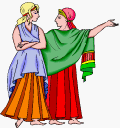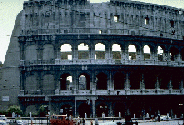|
Roman Religion
In some ways Roman religion is a lot like Greek religion, but in other ways it is very different. Like the Greeks, the Romans thought that there were many gods, and that these gods each controlled different parts of the world: storms, the ocean, marriage, blacksmithing, and so forth.
The Romans were particularly interested in power, and much less interested in balance than the Greeks.
The chief of the gods, for the Romans, was Jupiter. His name is related to the name of the Greek god Zeus, and Jupiter is similar to Zeus in many ways. They are both sky gods who throw lightning bolts when they are angry.
For the Romans, as well, their emperors were gods, or something very close to gods, depending on who you asked. Generally in the eastern part of the Roman Empire,
in Egypt and Western Asia, people worshipped the emperors as gods. But in the western part, in Europe, people worshipped
only the emperor's guardian angel or something like that, not the emperor himself.
Roman Economy
Historians have been arguing for the last hundred years about how the Roman
economy worked. There are a lot of different possibilities, but the two main ideas are these:
 |
Many people think that the Romans had a very simple
economy. Most people were farmers, who ate mainly the food they grew themselves. They made most of what they needed themselves, clothes and furniture and tools, and rarely went to a store or a market. They didn't sell much either.
Every few months, though, tax collectors would come and take some of the food the farmers had grown. The tax collectors would
take this food to the cities, to feed the aristocrats and their slaves there, and they would send some of it on to feed the soldiers in the army, and some of it to Rome
to feed the Emperor and his court, and the people of |
Rome. This is sometimes called the "consumer city" model.
If this is true, we might expect that people would also live in very simple houses (the kind they could build themselves) and use very simple tools.
Other people think that the Roman economy was
much more complicated than that. These historians think that Roman farmers sold a lot of the food they grew at the market, and used the money to buy food and clothes and tools and furniture. Then they were able to pay their taxes in money, too, at least sometimes. In this view, the cities were not just eating the farmers'
food. The cities provided the markets and stores that farmers needed in order to sell their food and buy stuff. If |
 |
this is true, then we might expect to find people living
in nicer houses, and using more complicated tools.
These are both extreme views, and many
historians take a position somewhere in between, saying that farmers ate some of the food they grew, and made some of their
own clothes, but they also sold some food and bought some stuff. Thanks to new studies, and especially to archaeological excavations
of Roman farms and Roman cities, the situation is gradually becoming clearer.
click here for a website to Ancient Rome
Click here for the History of Ancient Rome


Answer the following Questions:
1. Why do the Romans need to build aqueducts? How are they made?
2. Why do the Romans practice slavery?
3. Why did the Roman empire grow?
4. Why is Rome considered an ideal city?
5. What is the origin of Rome?
6. How do the Romans practice politics?
7. What is the origin of the Punic War? Who are the leaders of the two warring groups?
8. What are the contributions of Rome to our modern day society?
9. What is the legacy of the Roman government to modern day America?
10. What caused the downfall of the Roman empire?


Roman Houses
The lower class Romans (plebeians) lived in apartment
houses, called flats, above or behind their shops. Even fairly well-to-do tradesmen might chose to live in an apartment-building
compound over their store, with maybe renters on the upper stories. Their own apartments might be quite roomy, sanitary and
pleasant, occasionally with running water. But others were not that nice.
In the apartment houses, or flats, an entire family (grandparents, parents, children) might
all be crowded into one room, without running water. They had to haul their water in from public facilities. Fire was a very
real threat because people were cooking meals in crowded quarters, and many of the flats were made of wood. They didn't have
toilets. They had to use public latrines (toilets).
The upper class Romans (patricians) lived very differently.
Their homes were single family homes, which in ancient Rome meant the great grandparents, grandparents, parents, and kids
of one family lived in a home together. Homes were made, quite often, of brick with red tile roofs, with rooms arranged
around a central courtyard. The windows and balconies faced the courtyard, not the street, to keep homes safe from burglars.
There were painting on the walls and beautiful mosaics on the floor. There was very little furniture, and no carpeting. Wealthy
Romans might have a house with a front door, bedrooms, an office, a kitchen, a dining room, a garden, a temple, an atrium,
a toilet, and a private bath.
The Romans made time, each day, to honor their gods
The ancient Romans had gods for nearly everything. There were temples all over the
Roman Empire. There was a temple in the Forum. Every home had a household god. Most ancient Romans had some sort of shine
in their home, which might be a small display or a grand, separate room, to honor the household god. The ancient Romans brought
offerings of meat and other items to many temples. Honoring their gods was part of ancient Romans everyday life.

the Baths!
The ancient Romans might hit the baths first, and
then wander down to the Forum, although many did prefer to get their shopping done early. In all but the largest baths, there
were separate hours for men and women. The women's time slot was apparently much shorter, so that women probably had to be
more careful scheduling. Large baths had duplicate facilities.
The Public Baths were extremely popular. Roman women and men tried to visit the baths at least once
every day. The baths had hot and cold pools, towels, slaves to wait on you, steam rooms, saunas, exercise rooms, and hair
cutting salons. They had reading rooms and libraries, as among the freeborn, who had the right to frequent baths, the majority
could read. They even had stores, selling all kinds of things, and people who sold fast food. The baths were arranged
rather like a very large mall, with bathing pools.
The baths were packed. The people loved them.
At one time, there were as many as 900 public baths in ancient Rome. Small ones held about 300 people, and the big ones held
1500 people or more! Some Roman hospitals even had their own bathhouses. A trip to the bath was a very important part of
ancient Roman daily life.
Could kids use the baths? No. Was there an admission
charge to the baths? Yes. Could slaves use the baths? Properly, no. But the people who could, as a matter of course, brought
their slave attendants with them.


The ancient Romans were great builders.
They built things to
last!
Roman Buildings: The Colosseum was built of concrete,
faced with stone, as were most amphitheaters. The Romans also used concrete (an ancient Roman invention!) to build
the dome of the Pantheon, a temple dedicated to all the Roman gods, which even today is still one of the largest single-span
domes in the world. They used concrete to build the underwater port facilities at Caesarea in Israel (fantastic technology,
still analyzed by modern engineers.)
 Roman Roads: Are you familiar with the expression "follow
the yellow brick road?" The Romans built thousands of miles of wonderful roads, to connect every part of the empire back
to Rome. Up until about a hundred years ago, people were still using these roads, as roads! In recent years, instead of
building new roads, modern engineers simply covered many of the old Roman roads with a coat of asphalt. The Romans did a wonderful
job building roads! Roman Roads: Are you familiar with the expression "follow
the yellow brick road?" The Romans built thousands of miles of wonderful roads, to connect every part of the empire back
to Rome. Up until about a hundred years ago, people were still using these roads, as roads! In recent years, instead of
building new roads, modern engineers simply covered many of the old Roman roads with a coat of asphalt. The Romans did a wonderful
job building roads!
To help people find their way, while traveling these roads, the Romans more or less invented
the milestone which grew increasingly wordy, and increasingly tall, to be easily readable from a vehicle. Some are 6 feet
tall. The milestone usually gave the mileage to the nearest large city, sometimes to an intermediate place as well; and the
date and perhaps who paid for the road.
There seems to have been no formal traffic code, including what side of the road to drive
on; but there were various laws about what you could and could not do on a given type and location of road, and when you could
do it. Roads were considerably less crowded, and much less travel than today. The real danger on a road was ambush by highway
robbers: which shows that a travelling vehicle could be alone on any given stretch of road.
Roman Aqueducts: As cities grew, the ancient
Romans needed more fresh water. To solve this problem, they built aqueducts. These were massive construction projects.
An aqueduct, properly speaking, is the entire conduit - from fresh water spring to town. (CONDUIT—A
natural or artificial channel through which fluids may be conveyed).
Where aqueducts had to cross valleys, some were built above ground, on arches. Most of the
time, they were underground conduits, and sometimes conduits lying right on the ground. These conduits could be made of clay
or wood, covered or encrusted with stone. The pipes inside the conduits, that carried the water, were made of lead, which
in turn required vast mining enterprises and then transportation to get all this pipe out into the field all over the empire,
although most of the lead was mined in Spain.
What is extraordinary about the aqueducts is the planning that must have gone into their
construction. Since the ancient Romans didn't use pumps, aqueducts had to be positioned at a relatively constant gradient
for dozens of miles. You try building something that drops by only 100 feet in 40 miles....and you'll begin to understand
why scholars refer to the ancient Romans as such great builders!
Roman Inscriptions: You may have heard that the ancient Romans could not read or write. Actually, the ancient Romans wrote quite a bit.
Much of their pottery was signed. Very often, the bricks used to make buildings were stamped with their makers names. Lead
pipes leading to these buildings, by law, were stamped. Scholars have found 200,000 Latin inscriptions and, incredibly, several
thousands are still being found every year! From a stash of letters written by just plain enlisted men, preserved by being
waterlogged from being dumped in a well in Scotland, it would appear that some of the Roman army could read and write. Scholarly
estimates are at around 30% of all adult men in Imperial times had the ability to read and write.
|
